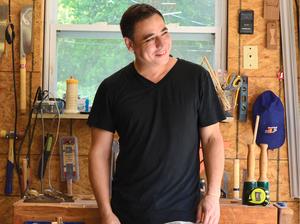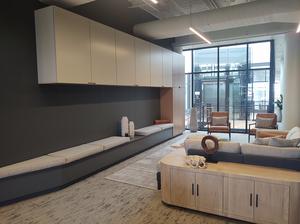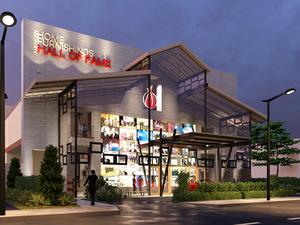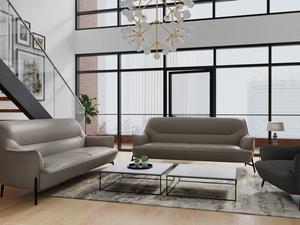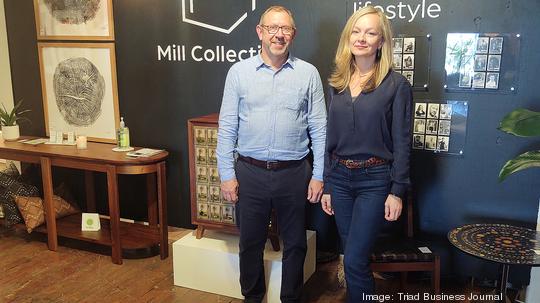
Several blocks removed from the heart of the High Point Market District, some might say, is where you find its soul.
In a three-story black building, literally on the other side of the tracks, 20 independent furniture crafters exhibited their original designs during the 2021 Fall Market that ended Wednesday.
On the top floor of the building at the corner of South Elm and Broad streets is where members of Mill Collective — in gallery style — each displayed two or three pieces of hand-made pieces with original designs. They come together each market as a community of crafters to capture the attention of interior decorators in a setting far removed from the glitz and glamour of major manufacturers’ showrooms.
A somewhat nomadic group, Mill Collective has most recently occupied 2,000 square feet in the Bobo Intriguing Objects building, its fourth venue since the collective was founded in 2017.
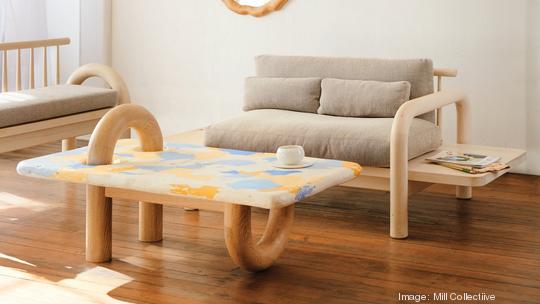
Originally hosted in the High Point facility of Cisco Pinedo of Los Angeles-based Cisco Home, who collaborated with its formation, Mill Collective does more than just provide the group space for the spring and fall markets. It is the also virtual front office for its 70 members over 16 states from coast to coast.
Based in Durham, Mill Collective co-founder Tim Branscome runs a three-person operation that markets the members’ products through a variety of channels including websites, social media and traditional media. In addition to bringing clients and crafters together, the Collective also helps with e-commerce activities, SKU inventory and more. The website highlights members’ works and provides links to their own websites.
“We’ve been able to evolve into that model whereas before we really just served as a marketing platform and the designers were going directly to the artisans, which they can do now,” Branscome said. “We can provide invoicing and act as a broker, looking after the interests of the interior designers because they are not customers of just one maker, but for several. We also look after the makers to make sure they're not being taken advantage of by holding the money in between (order and delivery) on our e-commerce platform.
“It's a lot easier to do business and we're trying to do business in a way designers are used to, but also in a way that fits the makers because they're in the workshop and it can be hard to reach them by phone.”
The maker movement
It was five years ago when Branscome and Pinedo recognized the maker movement in the home furnishings industry. Younger designers and makers, eschewing the corporate environment, were beginning to capture the attention of interior decorators — a growing presence at the High Point Market. The challenge was finding one another.
The members of Mill Collective have much in common with the designers. They trend younger, they operate independently, and a growing number of them are women, who make up half of Mill Collective’s membership, according to Branscome.
Meet award-winning designer Jermey Kamiya, a High Point resident and member of the collective
“I make that point because people often think of woodworkers as a bunch of grumpy old men setting beer cans on the furniture while they saw it down, but that's not the case at all,” he said. “These are people who are serious about it. They're trying to make a living out of it. Part of our selection process is we make sure that they have their own Instagram, they have their own website and they've registered the company. These are serious people, not just boneheads with a saw.”
With independent makers unable to afford their own showroom space in the heart of the market, Mill Collective first exhibited in 2017 at Cisco Home’s facilities before it needed the space for its own operations. Then came a few Markets at Plant 7 before its transformation into Congdon Yards began. From there it was on to Red Egg Furniture before landing at the Bobo building.
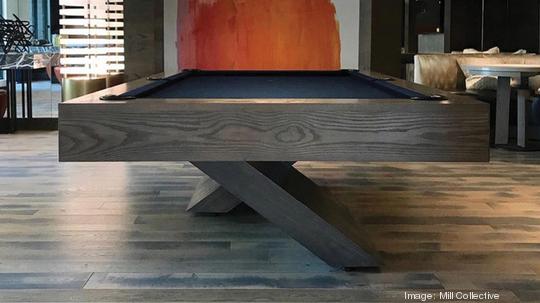
Despite the moves, Branscome said each Market draws more interior decorators to the Collective.
“It’s fresh air coming into the industry. The problem was they don't have the ability to make themselves visible,” Branscome said. “They’re creators and they're working in their workshop the whole day. They have limited resources and they live off what their hands produce. They can't step onto a platform like High Point because it is very expensive.
“Five years ago we estimated it cost $5,000 just to get your feet here. That’s a lot of money for these folks, and also they don't know how to do it. They had no one to advise them, so they get completely lost in a commercial environment.”
Mill Collective members aren’t competitors, either with major manufacturers or with each other. They work together, referring customers to each other, and this fall even pitched in to help a member set up who was unable to attend because of a case of Covid-19. They share resources and information with the common goal of helping each other grow.
“It's a different vibe,” Branscome said. “I come from a competitive background, so it's really nice to be, to be part of this.”
Suddenly competitive
By “this,” Branscome means a noticeable shift in the dynamics of the home furnishings industry in favor of the makers. Market buyers order products by the container. The growing presence of interior decorators, on the other hand, are seeking to source unique products for individual clients. Mill Collective provides the connection between the two.
As supply chain disruptions continue to delay furniture deliveries three months and beyond, it levels the playing field for the makers.
“People would come to us three years ago and they say they couldn’t wait 12 weeks. With the supply chain broken, now we say 12 weeks and they’re excited,” Branscome said. “It’s the same for our prices. Everything here is 100% American-designed and made. Our prices aren't affected by anything that's happening in Asia or Mexico or anywhere else, and they’re actually getting closer to what is over there.”
A piece by a maker can also go from idea to prototype in a month, whereas in the corporate process a new style can take 18 months from concept to shipping.
“One advantage that we have versus a larger a larger company is in bringing new product,” Branscome said. “Our guys can think of something and sketch it out at the beginning of the month, and by the end of the month they've got a live furniture piece. Our pieces are always current. It is what's happening now in real time versus what somebody thought about 18 months ago.”
With millions of square feet and hundreds of showrooms, even those who shop the Market the full five days can see only a fraction of it. They can shop Mill Collective’s gallery anytime online by taking a virtual tour of each Market.
“There's a lot of competition out there and people don't have time to look at every single maker, but if you're under under an umbrella, if you've got a common program and a common platform, people can find you. By working as an umbrella group we become a bigger needle in the haystack.”
